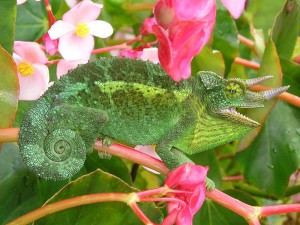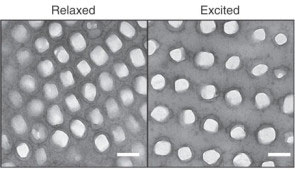|
COLOUR CHANGES - CHAMELEON EFFECT and IRIDESCENCE
|
 Movingsaletoday Muhammad [Public domain], Wikimedia Commons
Movingsaletoday Muhammad [Public domain], Wikimedia Commons
 TEM image of a chameleon skin resting and in excitement condition. Nature Comm. 6:6368 (2015)
TEM image of a chameleon skin resting and in excitement condition. Nature Comm. 6:6368 (2015)
|
What causes colour changes in chameleons? Chameleons have the capacity to rapidly change the colour of their skin depending on their mood or environmental conditions such as light or temperature and can camouflage with the environment. This amazing capacity is not due to true pigments but to what is known as structural colours. The key to the colours observed is at the nanoscale. This is a physical optical interference phenomenon. Thanks to the reorganisation of a guanine nanocrystal network present in the skin cells of these reptiles, interaction with incident light and its different colours can be controlled, reflecting some (from blue to red) while absorbing others. The chameleon modifies the density of the nanocrystal network and therefore changes the colour reflected on its skin. Its artificial equivalent are photonic crystals, nanostructured materials made up of nanocrystal networks which are organised in space and/or time. Iridescent Butterfly - an ultra-sensitive biosensor Iridescence is an optical phenomenon generating light tone variations according to the angle where it is observed. This is what we see for example on the playable side of a laserdisc. The Morpho butterfly has a shiny or iridescent appearance due to a complex nanostructure capable of absorbing and modulating light. This structure is formed by a layer of minute scales which are also made up of hundreds of nanometre-size width crests. Furthermore, the natural colour of butterfly wings changes when exposed to heat or certain gases and chemicals as a result of its nanostructure expansion. Nanocoatings with flip-flop effect Nanotechnology has successfully imitated the iridescence property also known as flip-flop effect, by developing nanocrystal coatings of titanium oxide (≈2nm-5nm). Examples in nature Chameleon, iridescent butterflies, opal (mineral), diatoms (algae), etc. Possible applications Ultra-sensitive heat sensors, night vision lenses, heavy duty technical coatings, active camouflage fabrics, etc.
|










